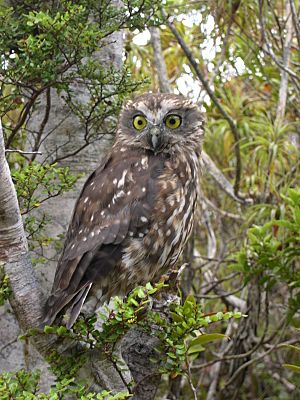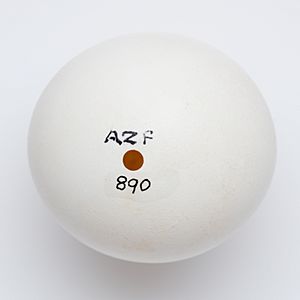Morepork facts for kids
Quick facts for kids Morepork |
|
|---|---|
 |
|
| Morepork in New Zealand | |
| Conservation status | |
| Scientific classification | |
| Genus: |
Ninox
|
| Species: |
novaeseelandiae
|
The morepork (Ninox novaeseelandiae), also known as the ruru or Tasmanian spotted owl, is a small brown owl. You can find it across New Zealand and Tasmania. Its name comes from its special two-tone call, which sounds like "more-pork".
This owl has dark brown feathers with light spots. It also has bright golden-yellow eyes. Moreporks are usually active at night (nocturnal). They sometimes hunt at dawn and dusk. During the day, they rest in hidden spots among tree leaves. Moreporks eat insects and small animals. They hunt by diving down from tree branches. The International Union for the Conservation of Nature says the morepork is a "least concern" species. This means it is not currently endangered.
Contents
About the Morepork's Name
The morepork was first described by a German naturalist named Johann Friedrich Gmelin in 1788. For many years, people thought it was the same species as the Australian boobook. However, in 1999, scientists decided they were different species.
The official name for this bird is "Morepork." It has almost 20 other names, like "mopoke" and "boobook." Many of these names sound like the bird's unique two-pitched call. This type of name is called onomatopoeic.
Morepork Types
There are four types, or subspecies, of the morepork. Two of these subspecies are now extinct.
- N. n. albaria, called the Lord Howe boobook, disappeared from Lord Howe Island in the 1950s.
- N. n. leucopsis, the Tasmanian boobook, lives across Tasmania.
- N. n. novaeseelandiae, the main type, lives in the North and South Islands of New Zealand.
- N. n. undulata, the Norfolk boobook, now only exists as a small mixed group. The last female of this type disappeared in 1996. She had mated with moreporks brought from New Zealand.
What the Morepork Looks Like
The morepork is about 26 to 29 centimeters (10 to 11 inches) long. Female moreporks are a bit bigger than males. Females weigh around 170 to 216 grams (6 to 7.6 ounces). Males are lighter, weighing about 140 to 156 grams (4.9 to 5.5 ounces).
Their head and upper body are dark brown. They have light brown spots on their head and neck. There are white marks on the rest of their upper parts. They have a pale yellow-white "eyebrow" stripe. Their eyes are yellow or golden-yellow. The feathers on their chin and throat are light brown with dark centers. Their belly feathers are mostly dark brown with light spots and streaks. This makes their belly look paler. Their tail is dark brown with lighter brown stripes. Their beak is pale blue-grey with a black edge. Their feet are orange or yellow with black claws.
Young moreporks don't get their full adult feathers until they are three or four years old. Young owls have white, fluffy tips on their feathers. These are left over from their baby down. Their feathers are also a darker, more grayish brown than adult owls.
Where Moreporks Live
Moreporks live in many places with trees. In Tasmania, they mostly live in eucalyptus forests. In New Zealand, they live in forests with different types of trees, including Podocarpus and Nothofagus. They can be found up to the tree line in mountains. On Norfolk Island, they live in forests of Norfolk Island pine.
In New Zealand's North Island, they are common in certain areas. These include places like Rangaunu Harbour and Taranaki. In the South Island, they are more common west of the Southern Alps. They are also found around Marlborough and in Southland. You can also find them on Stewart Island and other islands near the coast.
Moreporks are common in Tasmania. They also live on King Island and other islands in Bass Strait. They have been seen in southern Victoria, Australia, and once in New South Wales.
Morepork Behaviour
Moreporks are usually seen alone, in pairs, or in small family groups. These groups include an adult pair and up to three young owls.
Swamp harriers might sometimes hunt young moreporks.
During the day, moreporks sleep in their roosts. Even though they are mostly active at night, they sometimes hunt at dawn and dusk. Their main hunting times are in the evenings and mornings. They might also have short bursts of activity throughout the night. On very dark nights, they often rest for a few hours. If the weather is bad, they might even hunt during the day.
Reproduction and Life Cycle

Moreporks build their nests in tree hollows. They choose trees that are large enough to have these hollows.
Feeding Habits
Moreporks mainly hunt by perching and then pouncing on their prey. However, they are also very agile birds. They can fly quickly, like a goshawk. They can also move fast when chasing prey or catching insects in the air.
They eat many different animals. Their main food includes large insects like scarab beetles, huhu beetles, moths, caterpillars, spiders, and grasshoppers. In New Zealand, they also eat wētā. They will also eat almost any small animal they can catch. This includes small birds, rats, and mice. They can find good food sources in both pine forests and native forests.
Conservation Status
The morepork is a widespread and common species. The International Union for the Conservation of Nature lists it as a species of least concern. This is because it lives in a large area and its population seems stable. There is no sign of a big decline in their numbers.
Like most owls, the morepork is protected by the Convention on International Trade in Endangered Species. It is on the Appendix II list of vulnerable species. This means it is illegal to import, export, or trade wild-caught moreporks.
Images for kids
See also
 In Spanish: Nínox maorí para niños
In Spanish: Nínox maorí para niños





